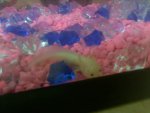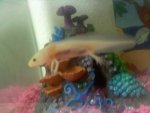"
Sand Alternatively, you might like to stick to using sand as substrate. Sand is made of minerals and tiny pieces of rock that have come from the erosion and weathering of rocks. The composition of sand varies from place to place depending on the sources and conditions of the local rocks. The most common constituent of sand in inland continental settings (e.g. deserts) and non-tropical coastal settings (e.g. beaches), is silica (silicon dioxide SiO2), often in the form of quartz.
The most suitable for aquarium use by far is silica based sand. Marine sand which is made up of coral that has passed through the digestion system of the parrot fish should not be used in freshwater applications, as it causes severe shifts in water hardness and alkalinity.
Arkose is a sand or sandstone with a high content of feldspar (an Aluminum Silicate), usually derived from the weathering and erosion of nearby granite. Feldspar has a negligible solubility in water so aluminum toxicity risk is at a minimum, however, this sand should be avoided as it is likely to contain various forms of lead and copper.
Natural black sand is comprised of mostly basalt and obsidian, and is safe to use. Natural white sand is mostly silica and is also safe to use. Most commercially available sands for pet trade use are made from one of these two.
Most commercial sands are thoroughly washed and sifted. These are sold by many sizes and grades. Sedimentary based sands containing high amounts of shale should be avoided. Silica and quartzite based sands are perfectly safe, as long as they have not been premixed with dangerous substances like Portland cement or lime. An acid test with muretic acid should be used to determine the safety of the sand. If it fizzes in the presence of an acid, it is unsuitable for aquarium use.
Play sand is an inexpensive option to many axolotl keepers, however, one must keep in mind it will need to be very carefully washed and sifted prior to use. It should also be tested with a magnet for the presence of iron oxides that can cause damage to your expensive filtration systems. Any sand showing any magnetic particles should be exempted from aquarium use.
Sand sold for use in the construction trades should be avoided, as should sand designed for use in swimming pool filtration systems. These sands are often chemically treated, or contain undesirable substances for aquarium use.
Most commercial sands sold for freshwater use in the pet trade are completely safe to use after washing. Sands sold for terrestrial enclosures, or “reptile safe“sand should be avoided as they are often various forms of limestone and can wreak havoc on water quality. One should be careful not to use sand at a depth greater than 2cm, as this can lead to detrimental effects from anaerobic bacterial action, causing formation of gas pockets. These gas pockets when stirred and disturbed, release an unpleasant odour and can also cause dark streaking bands to form across the substrate layer."
From
http://www.caudata.org/axolotl-sanctuary/Aquascape.shtml
That article says to avoid pool filter sand, but most Axolotl owners who have used it have had no problem. I would look at any labels to make sure nothing has been added.


